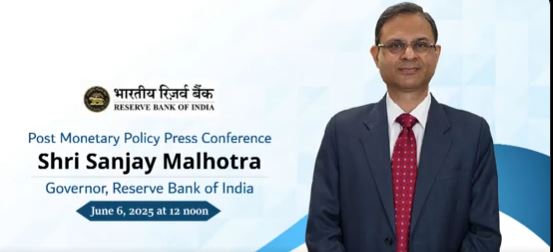RBI cuts repo rate by 50 bps: The Reserve Bank of India’s Monetary Policy Committee (MPC) has announced key decisions, cutting the policy repo rate by 50 basis points to 5.50 percent and shifting its stance to neutral. This move aims to boost growth given a positive inflation outlook, despite a fragile global economic backdrop.
MPC Decisions and Rationale
The MPC met from June 4-6 and decided to reduce the policy repo rate by 50 basis points (bps) to 5.50 percent with immediate effect. Consequently, the standing deposit facility (SDF) rate is now 5.25 percent, and the marginal standing facility (MSF) rate and Bank Rate are 5.75 percent.
This decision was driven by:
Significant softening of inflation over the past six months, now well below the 4 percent target, with expectations of it possibly undershooting the target during the year. Food inflation remains soft, and core inflation is expected to be benign due to easing international commodity prices. The inflation outlook for 2025-26 is revised down to 3.7 percent.
The need to stimulate domestic private consumption and investment to boost growth, which remains below aspirations due to the challenging global environment.
Given that the repo rate has been cut by 100 bps in quick succession since February 2025, the MPC also decided to change its policy stance from accommodative to neutral. The MPC will now carefully assess incoming data to balance growth and inflation moving forward.
Growth and Inflation Outlook
Growth
India’s real GDP growth for 2024-25 is estimated at 6.5 percent. Domestic economic activity remains robust, supported by:
A strong agriculture sector with good harvests and healthy reservoir levels.
Gradually gaining industrial activity and continued momentum in the services sector (PMI services strong at 58.8 in May 2025).
Healthy private consumption, with improving rural and urban demand, and reviving investment activity.
Strong merchandise exports in April 2025, and continued growth in services exports.
Looking ahead, the expected above-normal monsoon and sustained services activity should further boost rural and urban consumption. Healthy bank and corporate balance sheets, government capital expenditure, and improving business optimism are expected to revive investment. However, global uncertainties and geopolitical tensions pose risks. For 2025-26, real GDP growth is projected at 6.5 percent.
Inflation
CPI headline inflation continued its decline, reaching a nearly six-year low of 3.2 percent (year-on-year) in April 2025, primarily due to falling food inflation. Fuel inflation reversed its deflationary trend, and core inflation remained stable.
The outlook for inflation suggests benign prices across most components, driven by:
Record wheat production and higher pulse production ensuring adequate food supply.
The likely above-normal monsoon benefiting the Kharif crop.
Moderating inflation expectations among households.
Continued moderation in global commodity prices, including crude oil.
Assuming a normal monsoon, CPI inflation for 2025-26 is now projected at 3.7 percent.
External Sector, Liquidity, and Financial Stability
External Sector
India’s current account deficit (CAD) is expected to remain low for 2024-25 and within a sustainable level for 2025-26, supported by strong services exports and remittances. Despite widening trade deficits, the external sector remains resilient. Foreign exchange reserves stood at US$ 691.5 billion as of May 30, 2025, sufficient to cover over 11 months of imports.
Liquidity and Financial Market Conditions
The banking system transitioned into a liquidity surplus by end-March, with ₹9.5 lakh crore of durable liquidity injected since January. This has led to the weighted average call rate trading at the lower end of the liquidity adjustment facility (LAF) corridor, indicating effective policy transmission to short-term rates.
To provide further durable liquidity and reduce banks’ funding costs, the RBI decided to reduce the cash reserve ratio (CRR) by 100 bps to 3.0 percent of net demand and time liabilities (NDTL). This reduction will be staggered in four equal tranches of 25 bps each, starting September 6, 2025, releasing approximately ₹2.5 lakh crore into the banking system by December 2025.
Financial Stability
Scheduled Commercial Banks (SCBs) and Non-Bank Financial Companies (NBFCs) show robust financial parameters, including improved asset quality, liquidity buffers, and profitability. Stress in retail segments like unsecured personal loans and credit cards has abated, though some stress in the micro-finance segment persists.
Also Read | Why Monaco is a Billionaire Magnet: A top wealth hub analysis










The dark side of trading: Risk, addiction, and financial fallout
Go Global with PayPal World: Connecting Every Digital Wallet
What is the 90% rule in the journey of trading?